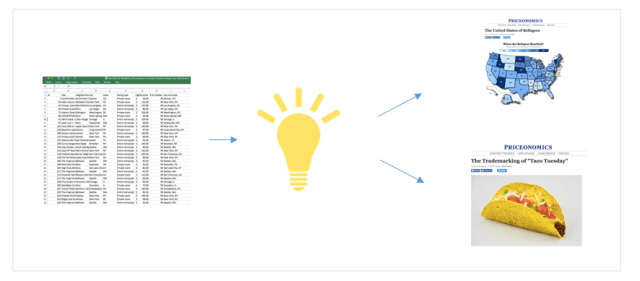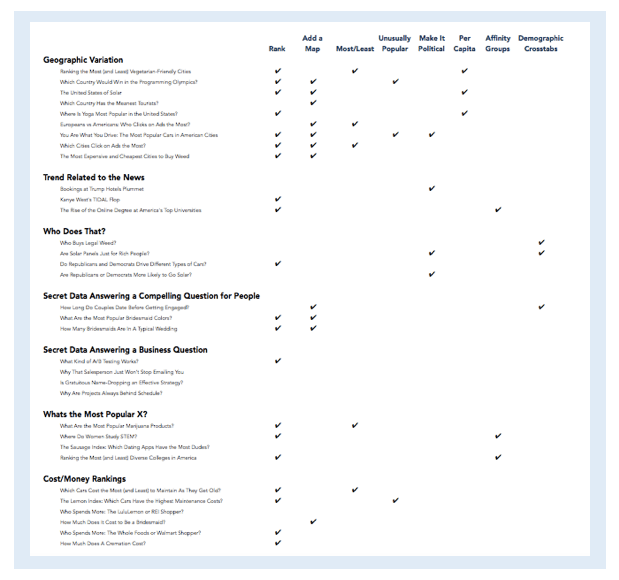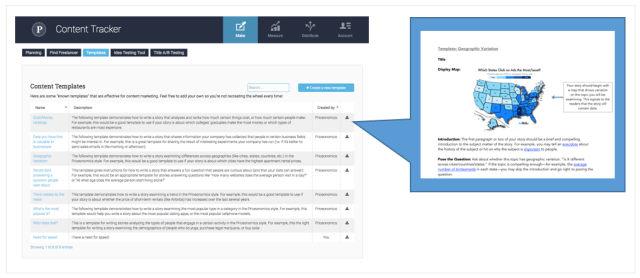
How can you reduce variability in a creative process?
***
A year ago, we published The Content Marketing Handbook, our first foray into helping companies make better content by using data.
The premise of the Handbook was that companies interested in content marketing should:
Write about information
Make it great
Have a plan for distribution
For the past year, our agency, the Priceonomics Data Studio, has worked with companies to turn their data into content that spreads. We’ve helped small startups and Fortune 500 companies, fashion sites and enterprise software firms. Content we’ve created together has hit the front page of Reddit and been referenced by the The New York Times. This happened organically, just by presenting information in the right way.
We’ve learned a lot about what works and what doesn’t.
We’ve also spent a lot of time thinking about how to make content marketing into a reproducible process. How can companies produce content on schedule that garners press mentions or customer leads? And how can companies do this on their own, without our help?
Today we’re introducing The Priceonomics Content Marketing Templates. The templates are do-it-yourself guides to writing data-driven content marketing. Each one is based on successful examples of content marketing we’ve done for our clients.
Templates are one feature of something new we’re rolling out this month. It’s called the Priceonomics Content Science Platform. If you’d like an early demo of the platform, send us a message and we’ll set up a time to talk.
Our Content Science Platform aims to let any company make great content marketing without hiring specialists (like us) or needing to spend $10K per month on a PR agency to spread the content. It lets you create and spread articles like you see on Priceonomics—articles that people want to share and that journalists want to write about.
A key part of our approach to making content marketing a science is to use templates to guide the process. In this post, we’ll walk you through how we came up with the templates, share a basic overview of our seven templates, and let you know how you can work with us to get a preview of the platform.
So, how did we get here?
Geniuses Not Wanted?

The Priceonomics Data Studio is our agency that helps companies turn their data into interesting content that people want to read. As we’ve worked with more companies, we’ve trained more writers and data analysts to help produce the work.
Over the course of the year, we’ve noticed three problems in our process:
- Variable Output: When working with new writers, their output can be inconsistent until they learn the “Priceonomics way” of writing and analysis. Put less charitably, sometime the first draft was not very good, because they didn’t receive proper guidance on our expectations. Editing their articles and giving feedback was a long, arduous process.
- Crazy Ideas: There are an infinite number of ways to write about a given data set. We needed a method to guide customers to successful approaches. Sometimes our Data Studio customers come up with ideas for articles that are unlikely to succeed. Sometimes we come up with ideas that are unlikely to succeed too. How do we stay focused on what works instead of going down the path of “wouldn’t it be cool if…”?
- Creative “breakthrough”: Initially, we’d meet a Data Studio customer and then brainstorm ideas until a “brilliant” idea came our way. How can we be less reliant on waiting for inspiration to strike? It’s a risky thing to rely on.
What we wanted was some sort of platonic ideal of a content marketing article that we could communicate to our customers and writers. That we’d know to make each time.
So, we reviewed every data-driven article we’d ever published. We wanted to see what had worked and define exactly what an excellent piece of content marketing should be. We were looking for patterns. And we found some.
It turns out that there are only seven different data-driven Priceonomics content marketing articles. And the articles that best fit these seven molds were particularly successful.

As much as we like to think of each of our articles as a unique snowflake, they aren’t. The ones that work follow a pattern. So we turned those patterns into templates.
The Templates

The actual templates are detailed guides about how to write stories without making too many wrong turns. Here’s an overview of our seven templates.
1. Geographic Variation: A key metric ranked by city, state, or country. Create an index based on your company’s core data asset and see how it varies by geography. For example, if you’re a car rental site, you can rank cities by where rental cars are most expensive.
2. Trend related to the news: What are reporters dying to write about right now? What do you know that is relevant to a story or topic dominating the news cycle? For example, do you have some data related to the election’s aftermath?
3. Who does that? A demographic breakdown of how people use your product or engage in an activity you can track. This is the right template if your product is particularly interesting and its usage is representative of the market. If your company sells marijuana, for example, who buys it?
4. Secret data answering a question people care about: I always wish I knew the answer! These are fun analyses based on your data that you could imagine people discussing at a cocktail party. A dating app might explain how many messages, on average, users have to send to get one date.
5. Data you have that is valuable to businesses: If businesses read your article, will they make more money? For B2B companies, this is the dominant template for content marketing. Can you benchmark conversion rates, things that lead to higher sales or lower costs?
6. What’s the most popular X? Market share rankings and “horse race” data. There is something particularly satisfying about definitive rankings of what is the most and least popular thing in a category people care about. If your company monitors grocery store transactions, what are the most popular cereals? Is it Lucky Charms?
7. Cost/Money rankings: What is the most expensive? Who makes the most money? If you sell dolls, which brands sell for the most money in the secondary market?
That’s it.
Virtually every data-driven article and piece of content marketing we produce follows one of these templates. No article is identical, but they start with a common skeleton and organization. A key part of that skeleton is the type of analysis and charts that fit each template. But beyond that, the templates help you write about data more clearly without going down the wrong path.
The extent to which we’ve deviated from these templates, we’ve encountered a world of hurt.
The Templates aren’t Magic, but They Work
Starting with a template can help you consistently produce quality work, but it’s hard to know where to start. Also, creating content is only a small part of a content marketing campaign.
Here’s what we do. With our customers, we come up with lots of different ideas and then map the most promising topics to a template. We start creatively, but quickly suck the creativity out the room to make sure we get the fundamentals of the article correct. After that, we sprinkle in more creativity.
Templates are part of our new Content Science Platform. The platform is a set of software tools to help you make, optimize, and spread content. You can use the seven Priceonomics templates to make better content marketing, but you can also upload your own to make sure your team is on the same page. There are a lot of other parts of the platform, which we can share with you if you want to talk.
There is a problem with templates, however. It takes some training and practice to get the hang of using them. If you’re a company that wants to make data-driven content marketing a core skill, we can help you with the process of turning your data into ideas and then executing them via templates. Once you get the hang of it, you can create data-driven content, build inbound links, and do content marketing at scale.
There are a lot of other parts of our Content Science Platform we’re excited to share with you. Some crazy, weird experiments we’ve been running, and some tools we’ve built that can be a substitute for a $10K / month PR firm. We’ll talk about all those in the coming weeks.
In the meantime, if you want a preview of our new content marketing platform, send us a message and we’ll set up a time to talk.



